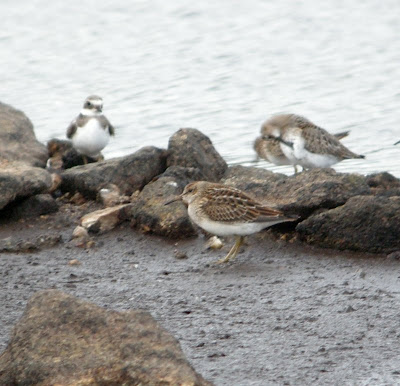This morning I awoke to find a reasonably thick fog enveloping Pendeen. A quick check on the Land's End webcam revealed that this wasn't just the regular local fog but something more extensive. Accordingly I was in no hurry to get out birding but first put in a decent session of painting. By mid morning things had started to brighten up somewhat so I headed over to Nanquidno to see what I could find. I was particularly interested in a Hawfinch sighting from the previous day and I also wanted to check the fields up by Little Hendra for Ortolan Buntings as this seemed to be a regular spot for them.
I'd forgotten just how many more birders there are down on the Penwith peninsula in October and whereas a month or so ago I could more or less have had the valley to myself now there were quite a few cars parked in the parking area and quite a few birders about though no one had seen anything. I gave the blackthorn a good grilling as apparently that was where the Hawfinch had been yesterday feeding on the sloe berries but to no avail. Up by Hendra House there was a huge flock of several hundred linnet with some goldfinches in amongst them and I spent some time searching through them for something rarer but again without any luck. On the way back up the valley I spotted a Peregrine sitting high on a rock surveying the surround area. Back at the ford I bumped into Dave Parker briefly who'd not seen anything of note either. I decided to round off my rather fruitless visit with a quick yomp over to Tregriffian Farm where the long-staying Pectoral Sandpiper had been remaining faithful to the small muddy pool at the back of the farm. Sure enough he was still there and I took a few photos though it was still misty and the light was poor. Then it was back home for lunch and my afternoon painting session.
With no news of anything major to hand I wasn't sure where to go for my afternoon birding expedition so when the Snow Bunting was reported as still being present at Sennen Cove I thought that to start with I would head over in that direction. I decided to have an explore along the north end of the Cycle Track that goes to Land's End and had just started out when I met a couple of birders who mentioned that not only had the Hawfinch been seen again at Nanquidno but also there'd been a Pied Flycatcher there as well. I quickly decided to head back there to see if I could catch up with either of these birds and cut short my Cycle Track walk. On the way over to Nanquidno I nipped into the upper Pay & Display car park where sure enough the Snow Bunting was hopping around in the middle of the field as confiding as this species usually is. I took a few shots from the car window and then headed back to Nanquidno.

As I pulled up in the parking area there were a couple of birders staring intently into the Sycamore trees there and it turned out that they'd just been watching the Pied Flycatcher and told me that it was appearing regularly at this spot. I settle down to wait for its reappearance but unfortunately it wouldn't cooperate and after about half an hour I decided to try my luck with the Hawfinch instead. There were quite a few birds moving around in the Blackthorn including several Chiffies and a male Blackcap but no sign of the target finch. Back to the car park: still no flycatcher. A quick walk to the ford: nothing. Back to the car park: bingo - there it was! I took some snaps and watched it for a while. I know that Cornish locals don't get too excited about Pied Fly's which are fairly regular down here but back in Oxon they are very hard to get and this was a Cornish tick for me so I enjoyed watching this dainty little flycatcher. After a while I had one more fruitless try for the Hawfinch and then headed off home for food and my evening painting session.































